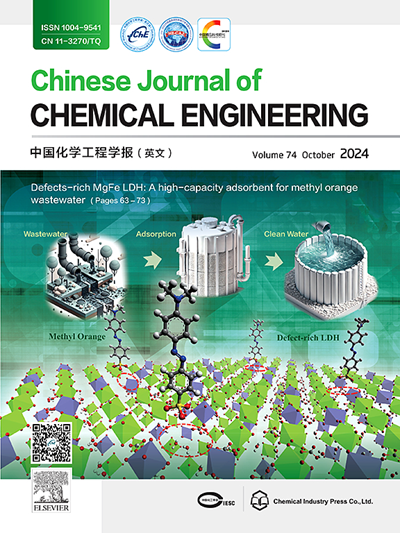NO reduction performance of pyrolyzed biomass char: Effects of dechlorination removal pretreatments
IF 3.7
3区 工程技术
Q2 ENGINEERING, CHEMICAL
引用次数: 0
Abstract
In the current era of renewable energy prominence, the wide operational capacity of coal-fired boilers has emerged as crucial for ensuring the sustainability of power plants. However, attaining ultra-low nitrogen oxides (NOx) emissions during periods of low-load operations presents a significant and persistent challenge for coal power enterprises. While techniques such as biomass re-burning and advanced re-burning have shown promise in enhancing NO reduction efficiency above 800 °C, their elevated levels of chlorine (Cl) and alkali metals pose potential risks to boiler equipment integrity. Therefore, this study proposes the utilization of biomass char derived from pyrolysis as a dual-purpose solution to enhance NO reduction efficiency while safeguarding boiler integrity during low-load operations. Findings indicate that pyrolysis treatment effectively reduces the Cl and alkali metal content of biomass. Specifically, it was determined that biomass char produced through deeply pyrolysis at 300 °C achieves the highest NO reduction efficiency while minimizing the presence of harmful components. At a reduction temperature of 700 °C, both re-burning and advanced re-burning techniques exhibit NO reduction efficiencies of 55.90% and 62.22%, which is already an ideal deficiency at low temperatures. The addition of water vapor at 700–800 °C obviously avoids the oxidation of ammonia to NO in advanced re-burning. Upon further analysis, denitrification efficiency in biomass char re-burning and advanced re-burning is influenced not only by volatile content but also by physicochemical properties such as porosity and surface functional group distribution under certain reaction conditions. This study provides a theoretical framework for the industrial implementation of biomass char for NO control in coal-fired power plants, offering insights into optimizing NO reduction efficiency while mitigating potential risks to boiler equipment.
热解生物质炭的NO还原性能:脱氯预处理的影响
在当前可再生能源突出的时代,燃煤锅炉的广泛运行能力已成为确保发电厂可持续发展的关键。然而,在低负荷运行期间实现超低氮氧化物(NOx)排放对煤电企业来说是一个重大而持久的挑战。虽然诸如生物质再燃烧和高级再燃烧等技术有望提高800°C以上的NO还原效率,但它们的氯(Cl)和碱金属含量升高对锅炉设备的完整性构成潜在风险。因此,本研究提出利用热解产生的生物质炭作为一种双重解决方案,以提高NO还原效率,同时保证锅炉在低负荷运行时的完整性。结果表明,热解处理能有效降低生物质中Cl和碱金属的含量。具体来说,在300°C深度热解产生的生物质炭达到了最高的NO还原效率,同时最大限度地减少了有害成分的存在。在还原温度为700℃时,再燃烧和先进再燃烧技术的NO还原效率分别为55.90%和62.22%,这已经是低温条件下的理想缺陷。在700 ~ 800℃时加入水蒸气,明显避免了高级再燃烧中氨氧化为NO。进一步分析,在一定的反应条件下,生物质炭再燃烧和高级再燃烧的脱氮效率不仅受挥发分含量的影响,还受孔隙度、表面官能团分布等理化性质的影响。本研究为燃煤电厂工业实施生物质炭控制NO提供了理论框架,为优化NO减排效率同时降低锅炉设备的潜在风险提供了见解。
本文章由计算机程序翻译,如有差异,请以英文原文为准。
求助全文
约1分钟内获得全文
求助全文
来源期刊

Chinese Journal of Chemical Engineering
工程技术-工程:化工
CiteScore
6.60
自引率
5.30%
发文量
4309
审稿时长
31 days
期刊介绍:
The Chinese Journal of Chemical Engineering (Monthly, started in 1982) is the official journal of the Chemical Industry and Engineering Society of China and published by the Chemical Industry Press Co. Ltd. The aim of the journal is to develop the international exchange of scientific and technical information in the field of chemical engineering. It publishes original research papers that cover the major advancements and achievements in chemical engineering in China as well as some articles from overseas contributors.
The topics of journal include chemical engineering, chemical technology, biochemical engineering, energy and environmental engineering and other relevant fields. Papers are published on the basis of their relevance to theoretical research, practical application or potential uses in the industry as Research Papers, Communications, Reviews and Perspectives. Prominent domestic and overseas chemical experts and scholars have been invited to form an International Advisory Board and the Editorial Committee. It enjoys recognition among Chinese academia and industry as a reliable source of information of what is going on in chemical engineering research, both domestic and abroad.
 求助内容:
求助内容: 应助结果提醒方式:
应助结果提醒方式:


